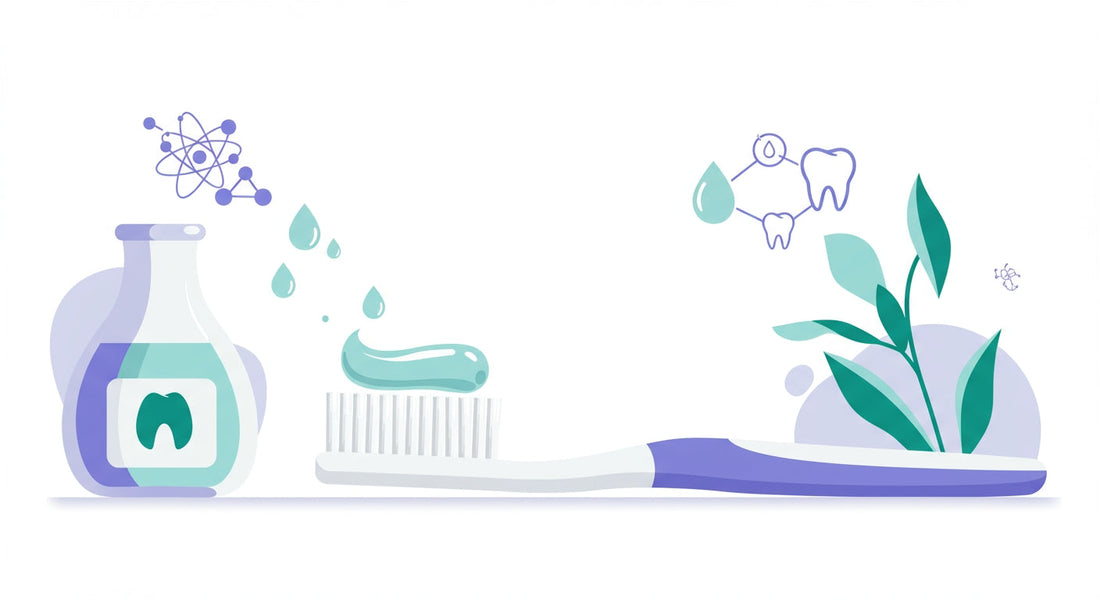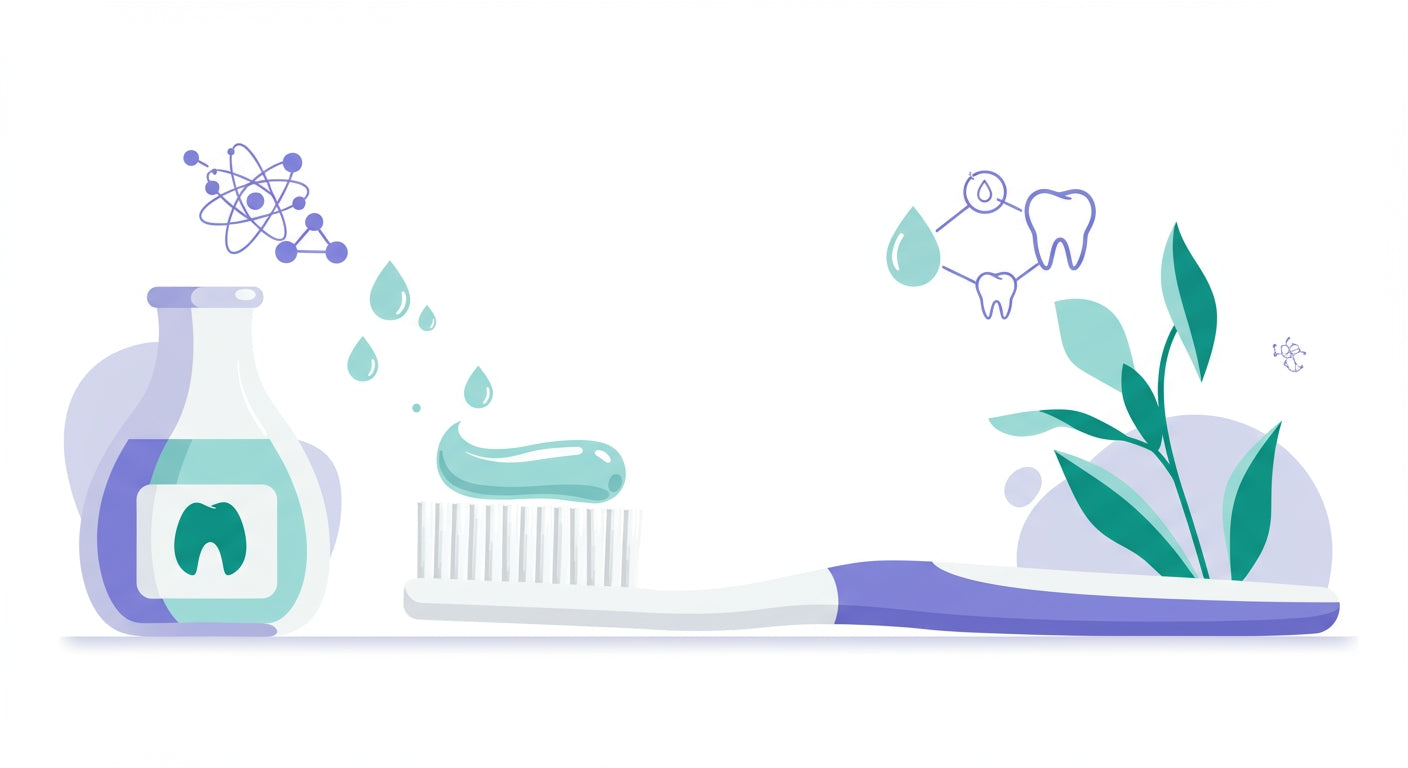Introduction – Why This Debate Matters
Every time you squeeze toothpaste onto your brush, you’re making a choice. For decades, fluoride has been hailed as the gold standard for cavity prevention. But wellness communities are asking: Is fluoride really safe—or are there hidden risks?
In this guide, you’ll learn:
✨ The real benefits and potential risks of fluoride toothpaste
✨ Science-backed alternatives like nano-hydroxyapatite (n-HAp)
✨ Practical ways to care for your teeth without the guesswork
What is Fluoride and Why It’s in Toothpaste
Fluoride basics:
- Strengthens enamel through remineralization 🦷
- Forms fluorapatite, a mineral more resistant to acid attack
- Inhibits cavity-causing bacteria
History & safety context:
- Added to toothpastes since the 1950s, leading to major reductions in cavities (Verywell Health)
- Regulatory bodies (WHO, ADA) endorse fluoride toothpaste as safe when used properly
📚 Reference: Colgate Professional Review on Fluoride Safety
Benefits of Fluoride Toothpaste
✅ Reduces cavities significantly across age groups
✅ Effective at concentrations of 1,000–1,500 ppm
✅ Strengthens enamel + reduces sensitivity
✅ Affordable, widely available
💡 Real-life example: A 2014 JADA study showed fluoride toothpaste reduced cavities in young children, but only when parents supervised brushing and ensured kids didn’t swallow.
Risks & Controversies
While generally safe, overexposure and context matter.
| Concern | Evidence | Mitigation |
|---|---|---|
| Fluorosis in kids | White spots/discoloration if swallowed regularly | Use rice-grain/pea-sized amount & supervise |
| Systemic health risks | Some meta-analyses link high water fluoride to lower IQ in kids | Topical use in toothpaste is far lower exposure |
| Overuse in kids | Marketing encouraged excessive application | Brands now face lawsuits & regulatory pushback |
| Pregnancy/kidney issues | Extra caution needed in vulnerable groups | Consult dentist/doctor for alternatives |
📚 Reference: Frontiers in Oral Health, 2022
Safe Usage Guidelines
For adults:
- Use a pea-sized amount twice daily.
- Brush, spit, don’t swallow.
- Don’t rinse immediately—let fluoride coat teeth.
For children under 6:
- Rice-grain smear for toddlers, pea-size for 3+ years.
- Supervise brushing.
💡 Quick practice: Next time you brush, measure out a true pea-sized amount—it’s less than you think!
Fluoride-Free Alternatives That Work
🌱 Nano-Hydroxyapatite (n-HAp)
- Mimics natural enamel
- Repairs microdamage and reduces sensitivity
- Studies show non-inferior to fluoride for cavity prevention
- Safe up to ~10% concentration in toothpaste
📚 Reference: Frontiers in Public Health, 2023
🌱 Xylitol
- Natural sugar alcohol
- Reduces cavity-causing bacteria
- Often blended in natural toothpastes
🌱 Baking Soda & Calcium Carbonate
-
Gentle abrasives that clean and neutralize acidity
🌱 Essential Oils & Aloe
-
Provide mild antibacterial support
💡 Practice to try: Test a fluoride-free toothpaste (like Boka or Davids) for 2 weeks. Track sensitivity and freshness compared to your usual paste.
How to Choose the Right Toothpaste
When choosing:
- Check fluoride concentration (1,000–1,500 ppm if using fluoride).
- Look for clinical studies (ADA seal or peer-reviewed references).
- Avoid unnecessary additives (triclosan, SLS, dyes).
- For natural care, look for n-HAp or xylitol-based formulas.
FAQ – People Also Ask
Is it safe to use a pea-sized amount of fluoride toothpaste twice daily?
👉 Yes. Studies confirm this is safe and effective for adults with normal health.
Does fluoride cause cancer?
👉 No credible evidence supports this claim for topical fluoride use.
Can children use fluoride toothpaste?
👉 Yes—but only in small, supervised amounts to prevent swallowing.
Can nano-hydroxyapatite replace fluoride?
👉 Yes, many studies show n-HAp is as effective for enamel repair and cavity prevention.
Closing Thoughts
Fluoride toothpaste has undeniable benefits when used properly. But powerful alternatives like nano-hydroxyapatite offer new options for those seeking a fluoride-free path.
✨ The best choice is the one that matches your health profile, lifestyle, and values.
✨ Consistency in brushing, flossing, and diet matters more than any single ingredient.
📌 Comment below: Will you stick with fluoride, try n-HAp, or use both?
🦷 General Oral Health Practices That Go Beyond Toothpaste
While choosing the right toothpaste matters, strong oral health is about more than brushing. These simple habits can make a big difference in keeping your mouth clean and your smile strong:
-
Chew xylitol gum 👉 Xylitol reduces cavity-causing bacteria and stimulates saliva flow, which naturally neutralizes acids and supports enamel remineralization.
-
Try oil pulling 👉 Swishing coconut or sesame oil for 5–10 minutes can help reduce harmful bacteria, freshen breath, and support gum health.
-
Floss gently 👉 Flossing daily removes plaque and food particles where your brush can’t reach, reducing the risk of cavities and gum disease. Be gentle to avoid gum irritation.
-
Clean your retainers! 👉 Retainers, mouthguards, or aligners can become nests for bacteria if not cleaned daily. Rinse thoroughly, brush them with non-abrasive paste, or use retainer cleaning tablets.
💡 Small, consistent actions add up. Oral health isn’t just about your teeth — it’s about caring for the entire mouth ecosystem.
📚 Suggested Reading/Listening:
- Fluoride in Dentistry by Ole Fejerskov — a leading textbook on fluoride’s effects in oral health.
- Nutrition and Physical Degeneration by Weston A. Price — classic holistic perspective on diet and dental health.
- The Dental Diet by Dr. Steven Lin — integrative look at food, microbiome, and strong teeth.
- Hydroxyapatite and Oral Care (podcast episode, Ask the Dentist Podcast with Dr. Mark Burhenne) — deep dive into fluoride-free alternatives.
-
The Tooth and Its Enemies (journal article, British Dental Journal) — explores the science of decay prevention and fluoride’s role.
📬 Want more tools like this? Subscribe to the Motiv8em Newsletter for weekly wellness tools, rituals, and stories.
xo, Violaine


